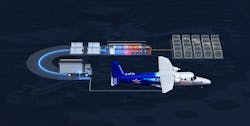ZeroAvia Makes Major Strides in Hydrogen Refueling with Shell Collaboration and Airport Pipeline Launch
ZeroAvia, a leader in hydrogen-electric solutions for aviation, today announced a collaboration with its strategic investor Shell, who will design and build two commercial-scale mobile refuelers for use at ZeroAvia’s research and development site in Hollister, California. The announcement follows recent positive predictions relating to the falling price trajectory of hydrogen fuel and a flurry of State-led activity for establishing H2 Hubs as the Department of Energy prepares to receive bids from across the U.S.
At ZeroAvia’s test facility in Hollister, Shell will also provide compressed, low-carbon hydrogen supply to the facility and other locations in the Western U.S. This strategic collaboration will support the development of ZeroAvia’s flight testing program in the U.S. following the arrival of its second Dornier 228 at Hollister last month and will advance the company’s Hydrogen Airport Refueling Ecosystem (HARE) on a larger scale.
ZeroAvia’s zero-emission powertrains use hydrogen fuel in a fuel cell to create a chemical reaction which produces electricity. That electricity then powers electric motors that spin the propellers, while producing no emissions other than water.
“Shell recognizes the aviation sector has unique challenges in decarbonization and needs practical and scalable net-zero solutions,” said Oliver Bishop, general manager, Hydrogen at Shell. “We believe ZeroAvia’s technology is a viable option, and this agreement will allow us to demonstrate successful provision of low-carbon hydrogen supply while supporting development of codes, standards, and refueling protocols for hydrogen-powered aviation.”
The deal with Shell comes as ZeroAvia also unveils Europe’s first landside-to-airside hydrogen airport pipeline. The 100 meter long hydrogen pipeline runs alongside ZeroAvia’s hangar at Cotswold Airport in the UK. The company will utilize it alongside an electrolyzer and mobile refueler to use low-carbon hydrogen for its test flight program. The pipeline will help ZeroAvia demonstrate and explore the operational safety case for hydrogen pipelines and refueling infrastructure at airports.
ZeroAvia received support for the pipeline from the UK Government’s Department for Transport and the Connected Places Catapult as part of the Zero Emission Flight Infrastructure (ZEFI) program to enable airports and airfields to prepare for the future of zero-emission operations.
Both projects also enable ZeroAvia to further explore the connection between aircraft refueling and landside hydrogen use cases, such as road transport. ZeroAvia operates multiple hydrogen fuel cell road vehicles as part of its operations at Cotswold Airport and Hollister, demonstrating the potential for airports to act as hydrogen hubs for onward transport and ground operations.
“These milestone announcements represent significant hydrogen infrastructure advancement for ZeroAvia and the industry,” said Arnab Chatterjee, VP infrastructure, ZeroAvia. “Hydrogen-electric aviation is the only practical, holistic, and economically attractive solution to aviation’s growing climate change impact. Fuel provision needs to be economical and convenient for airlines to achieve operational cost benefits and ZeroAvia is leading these pioneering infrastructure developments together with leading partners like Shell.”
The company has also been working alongside the Department for Transport and Connected Places Catapult on a concept study for liquid hydrogen mobile refueling vehicles. This will inform ZeroAvia’s development of a large-scale liquid hydrogen refueling truck, an important step as the company progresses its powertrains from gaseous to liquid hydrogen to support larger aircraft.
ZeroAvia will begin flight-testing its ZA600 hydrogen-electric powertrain this summer using its two Dornier-228 testbed aircraft, first in the UK, and later replicating this work on the US-based demonstrator. The development of this 600kW powertrain is part of Project HyFlyer II and will deliver a fully certified powertrain for aircraft of up to 19-seats by 2024. HyFlyer II is supported by the UK Government’s Department for Business, Energy and Industry Strategy (BEIS), Aerospace Technology Institute (ATI), and Innovate UK through the ATI Programme. The company is also now retrofitting a second Dornier-228 testbed in Hollister, California, to conduct further flight testing.
Earlier this month, ZeroAvia also announced its partnership with ZEV Station to develop hydrogen hubs at airports throughout California. These announcements signify ZeroAvia’s leadership in zero-emission powertrain technology and corresponding hydrogen infrastructure to support the transition to cleaner aviation solutions.
